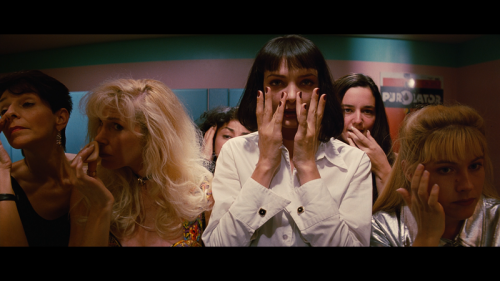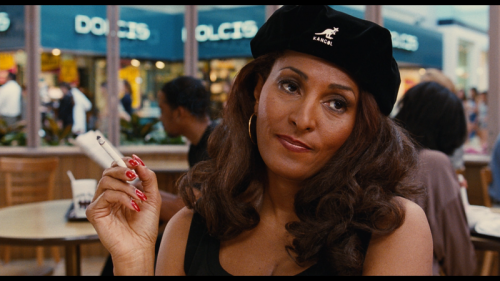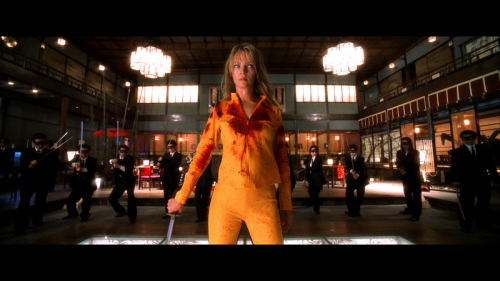
This guest post by Emanuela Betti appears as part of our theme week on Male Feminists and Allies.
I’ve often considered Quentin Tarantino the new Russ Meyer for various reasons: bringing exploitation cinema to mainstream screens, their unconventional humor and unique storytelling, and in particular for their celebration of women. Roger Ebert called Russ Meyer a feminist filmmaker, and although Tarantino never openly called himself a feminist, many of his films place women at the center of the story. Just like Russ Meyer’s films, Tarantino’s women are the stronger sex: they are sharp-minded, better fighters, and always outsmarting their male counterparts. The men, on the other hand, often underestimate women, like Ordell in Jackie Brown or Stuntman Mike in Death Proof, resulting in them being the butt of the joke.
Watching a Tarantino movie is like watching the 1973 Battle of the Sexes tennis match, in which Billie Jean King defeated Bobby Riggs, proving that women are just as equally skilled and able as men. In many Tarantino movies, the idea of gender equality is prominent in many ways—take for example the two screenplays written by him before his directorial debut: True Romance and Natural Born Killers. Both stories revolve around a Bonnie-and-Clyde outlaw couple; however, the female characters are not merely ornamental girlfriend, but “partners in crime,” as in both genders are equally involved in the story. Later, we see the theme of outlaw partnership between Jackie Brown and Max Cherry, when at the end Jackie tells Max, “I never lied to you … we’re partners,” and also with Pumpkin and Honey Bunny in Pulp Fiction. A partner is a more respectable role, because she’s not there for the male protagonist, but is a protagonist with him. The idea of equality is present in another way, taking for example Kill Bill and Death Proof. In these two movies, the main characters are doubles: Beatrix and Bill are both equally able fighters, while Zoe Bell and Stuntman Mike are both professional stunt performers, and are equally prepared to react to a dangerous situation.
In a recent Natalie Portman interview, the actress shed some light on the fallacy of Hollywood’s idea of a feminist character, saying that a woman kicking ass is not necessarily feminist, it’s “macho.” I agree, and projecting male qualities onto women is not about celebrating women’s strengths. When looking at Tarantino characters, we see female characters with strong motives and personal qualities, who are strong, smart, yet still very complex. I will focus on his most women-centric films: Jackie Brown, Kill Bill, and Death Proof.

Like Pulp Fiction, Tarantino’s follow-up movie Jackie Brown was a love letter to cinema (Blaxploitation) and its icons (Pam Grier). The opening sequence is a reference to The Graduate, in which we see a character “gliding” through LAX. Like the movie it references, Jackie Brown is a story about age—getting older, and dealing with that stage in life. While The Graduate is about entering adulthood, Jackie Brown is about middle-age, or entering middle age. We see the theme of aging in Max Cherry, but mostly in its female title character and protagonist. Jackie Brown was an homage to Pam Grier and her character Foxy Brown, and although we still get a glimpse of Foxy Brown’s nerves of steel and fierceness, in Jackie Brown she is an older version, worn down by age and a lousy job as an airline stewardess. Her gender is not so much an issue though–Detective Dargus mocks Jackie not so much for being a woman, but her age, and her less-than-impressing accomplishment in life. Yet she still possesses a sharp mind and infallible instincts, which is why she’s one step ahead of every other character.
Jackie’s main antagonist is Ordell, who underestimates Jackie and women in general. Tarantino has the ability to surprise, not only with story, but also with character development. We begin with a middle-aged black woman working at a small airline against a gun dealer who has big money and no scruples; but Jackie’s toughness begins to unfold, while Ordell’s “cool” and control begin to unravel–even Melanie, a minor female character–sees through Ordell’s pompous attitude and tries to outsmart him by plotting to steal his money. At the end, Jackie comes at the top, while Ordell becomes the butt of the joke.

Tarantino has said that his movies belong in two different universes: the real world (such as Reservoir Dogs, Pulp Fiction, and Jackie Brown), and the “film world.” The Kill Bill movies are the first Tarantino stories to take place in the “film world,” which is a universe based on Tarantino’s adoration for past genres. Every Tarantino movie is a love letter to cinema, and just like Jackie Brown was an homage to Blaxploitation, Kill Bill was a love letter to the Shaw Brothers, samurai and yakuza movies, Sergio Leone and spaghetti westerns. Beatrix Kiddo/The Bride is one of the toughest female fighters in cinema, but in contrast to Hollywood’s one-dimensional kick-ass female characters, she defies the stereotype of the “macho-feminist.” She is a very tough fighter, she is cold-blooded, but at the same time she is also a very complex woman. With a strong female lead, Tarantino could have easily relied on her as the sole woman in the story, but the movie is packed with interesting female characters. There’s Vernita Green, who is almost a parallel of the protagonist: she quit her job as an assassin and has a daughter, but is still a cold-blooded fighter when confronted with the Bride. There’s Gogo Yubari, the teenage bodyguard, who is more lethal than all the Crazy 88 put together. O-Ren, a female yakuza leader, is given a tragic backstory, which is also tainted in revenge, and offers a compelling view into her character’s development. Despite being a woman and leader of the Tokyo yakuza, her gender seems to hardly be an issue–the only complaint she receives is about her mixed heritage, not her gender. In the world of Kill Bill and Tarantino’s narrative style, women are not “the Other,” and the fact that a woman could lead a yakuza army or be the best fighter in the world is not unusual, and maybe even expected.
Volume 1 is about the Bride’s rage, while Kill Bill Volume 2 is about the emotional development of the characters: we are shown the desires and vulnerabilities of the protagonist and her enemies. While initially presented as a deadly killer, we finally see the Bride’s complex development: she begins as a naïve pupil, blushing at Bill’s every word, but begins building a tough skin under Pai Mei’s teaching. The main female villain in Volume 2, Elle Driver, is also another parallel to the Bride–they’re both blonde, they were both Bill’s girl–but at the same time, they’re opposites. Elle Driver has all the negative aspects of a female killer: she’s a back-stabbing, dirty fighter. Elle Driver is also obsessively clingy about Bill; she is based on Patch from Switchblade Sisters, who was a second-in-command character, just like Elle Driver feels like second-best in the eyes of Bill, and her desire to kill the Bride is a competition fueled by her jealousy.
In Volume 2 we see most of the Bride’s development and emotional complexity. The various interactions between the Bride and Bill, during the dress rehearsal and at his home, reveal her conflicting feelings for him; at times she has nostalgic affection for Bill, but she never allows those feelings to sway her goals. While being a cold-blooded assassin, the Bride is also capable of strong maternal instincts when it comes to her daughter, especially when she fears for her child. The Bride is a complex character who can balance toughness and vulnerability, resisting stereotypes or clichés. She is a woman who undergoes multiple symbolic deaths–first, on the eve of her wedding, and then when she is buried alive, but she is reborn stronger and more determined.

Death Proof was criticized heavily, and some considered it Tarantino’s worst movie. The movie was protested by Scottish women’s groups, including the Scottish Women Against Pornography (SWAP) and Scottish Women’s Aid, due to the portrayed sadistic violence against the female characters. In Tarantino’s response to the backlash, he admitted that slasher films do have a bad reputation for being misogynistic, but slasher/horror movies also have the Final Girl trope, or the “investigative gaze,” which is often overlooked. Slasher movies are the Big Mac and fries of cinema—they’re fast, cheap, and give you what you ask for. However, the Final Girl is the most redeeming trope in a mostly misogynistic genre. We see this trope of the “investigative gaze” used twice in Death Proof: first with Arlene, when she spots the suspicious Stuntman Mike, and then with Abernathy. It’s easy to assume that the protagonist of the movie is Stuntman Mike, since he is present throughout the story, but the true protagonists (or heroines) don’t show up until half-way through. Tarantino starts the story with the first trio of women (Jungle Julia, Arlene, and Shanna), who are brutally killed by Stuntman Mike after a night of drinking. The violence exerted on the first group of women is what you can expect from a typical slasher—violence and gore—but it also served as a plot device to establish the merciless and dangerous antagonist. Stuntman Mike’s reason for finding sadistic enjoyment in mutilating women is never explained, but it’s well depicted that he is the embodiment of the male gaze: creepy voyeuristic tendency, stalking and finding pleasure in objectifying his victims.
The second half introduces us to a new group of women—the heroines of the story. The “three girls” device is very typical of Russ Meyers (which he used in Faster, Pussycat! Kill! Kill! and Beyond the Valley of the Dolls). In Death Proof, Abernathy, Kim, and Zoe are the new pussycats. Like the previous women, they are also targeted by Stuntman Mike, and subsequently chased and attacked. But this time, the women are on par with their aggressor—they can drive just as fast, and they’re just dangerous as him. The car chase between Stuntman Mike and the women is incredibly exciting, because now the roles have been reversed—the women are the ones chasing Stuntman Mike, creeping up on him the same way he stalked and crept up on the previous women, and when they catch up they’re not forgiving. As much criticism this movie has received, when you watch the women exulting at the end, there’s no doubt that this is a movie for women, and not against them.
Tarantino has created dynamic and interesting female characters throughout his cinematic career, celebrating their strengths, personalities, and never presenting gender as an obstacle—instead, being a woman in his stories is often an advantage. Tarantino’s portrayal of women is based on developing them as characters and individuals, rather than focusing on their gender and their weaknesses.
See also at Bitch Flicks: “Tarantino’s Women,” by Jamie McHale; “From a Bride with a Hanzo Sword to a Damsel in Distress: Did Quentin Tarantino’s Feminism Take a Step Backwards in ‘Django Unchained’? by Tracy Bealer; “‘Reservoir Dogs,’ Masculinity and Feminism,” by Leigh Kolb; “The Gender Situation in ‘Pulp Fiction,'” by Leigh Kolb
Emanuela Betti is a part-time writer, occasional astrologer, neurotic pessimist by day and ball-breaking feminist by night. She miraculously graduated with a BA in English and Creative Writing, and writes about music and movies on her blog.
5 thoughts on “Revenge of the Pussycats: An Ode to Tarantino and His Women”
Comments are closed.